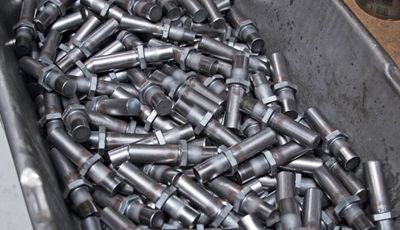
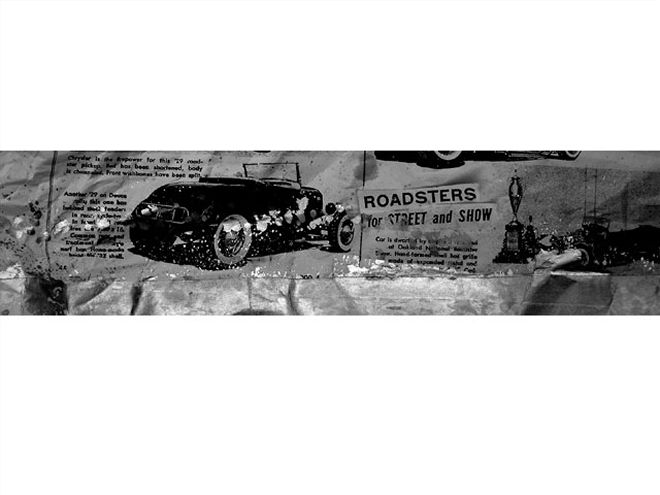
Next to rubber hoses and line, fastening hardware may be the least exciting components on your hot rod or custom car. Your dressed-up engine, fresh paint job, polished suspension parts, trick wheels, and custom interior may have you beaming with pride, but when's the last time you called up your buddies to come over and see your brand-new rod bolts?
The value of high-quality hardware goes way beyond their non-existent dazzle factor. Just ask anybody who has invested in high-strength fasteners after trying to get away with the cheap stuff, only to pay the higher price of broken parts.
Holding it in your hand, the 3/8-inch hex head bolt you pulled out of a bucket at Pop's Hardware Store may not look or feel a whole lot different than a high-strength fastener from ARP or Totally Stainless, but put it to the test on a connecting rod or a suspension component and the difference will become obvious very quickly.
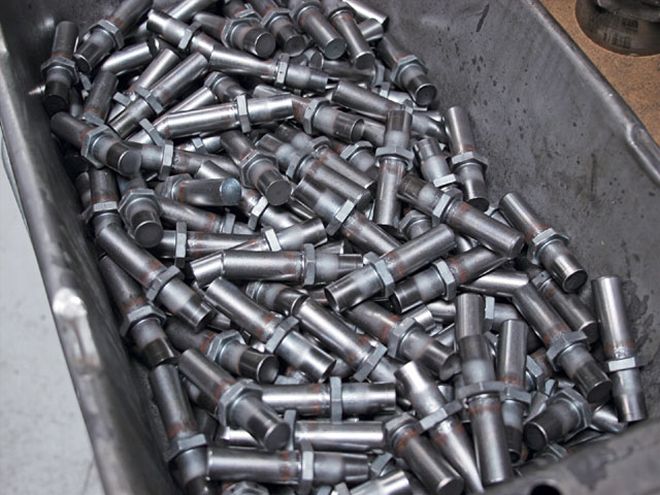 Every bolt, nut, and stud starts life like this, on a giant coil of steel. The wire is cut, the head formed, threads cut, end faced, and numerous other processes performed to turn this into a mountain of bolts.
Every bolt, nut, and stud starts life like this, on a giant coil of steel. The wire is cut, the head formed, threads cut, end faced, and numerous other processes performed to turn this into a mountain of bolts.
In order to find out what makes the difference in the quality of fasteners, we talked to Doc Hammett at Totally Stainless in Gettysburg, Pennsylvania, and we took a road trip to Automotive Racing Products (ARP) in Ventura, California, where Bob Florine gave us a tour of one of the company's several manu-facturing and testing facilities in nearby Santa Paula.
ARP has built its reputation on engine and driveline hardware for applications from professional racing to street cars. The majority of its product line is underhood fasteners-more specifically, cylinder head, main, and connecting rod hardware.
Probably the most familiar way of evaluating fasteners is by SAE Grades. The majority of fasteners on the market are rated as Grade 2, Grade 5, or Grade 8. Grade 2 fasteners, typically carbon steel, are at the weak end of the spectrum; carbon-alloy Grade 5 and Grade 8 fasteners are rated higher. You may have also seen the designation 18-8, which indicates stainless steel. The number refers to the makeup of the steel, approximately 18 percent chromium and 8 percent nickel, in addition to iron. Common 18-8 is slightly stronger than Grade 2 but less strong than Grade 5.
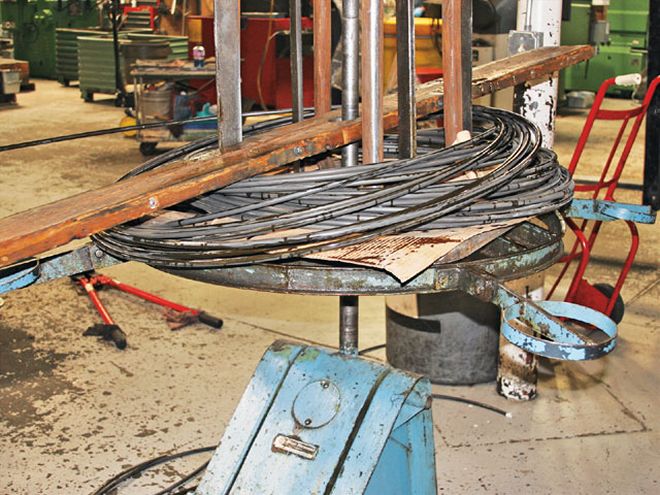
It's not enough for a bolt to be strong, Bob explained. It has to be flexible as well, in order to prevent it from snapping. Strength is described by several different criteria, the most common of which are tensile strength and yield strength. Tensile strength is determined by trying to pull the fastener apart toward the point of breakage. Bolts and studs are meant to be stretched so tensile loading will cause the bolt or stud to act as a clamp. Yield strength determines the load that a fastener can withstand before undergoing a specific permanent deformation-in layman's terms, how much it can take before it starts to permanently bend out of shape. Consider the range of motion of a connecting rod bolt and you can understand how this becomes important.
The chart on page 46 provides a quick look at how the various grades relate to each other in the area of yield strength and tensile strength.
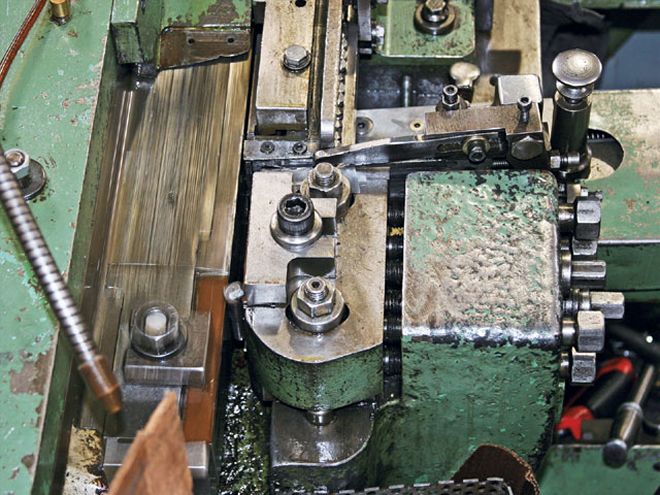 Look closely to see the threads being formed (arrow) on this rolling machine, one of several types.
Look closely to see the threads being formed (arrow) on this rolling machine, one of several types.
Of these SAE Grades, Grade 8 is the strongest, with a tensile strength of 150,000 psi, far higher than Grade 2. ARP and Totally Stainless have products begin above Grade 8, with tensile strengths in the neighbor-hood of 170,000 psi, and climb their way up from there.
One of the ways to strengthen fasteners is by hardening. Heat treating is the typical method with carbon steel. Bob explained that many of the fasteners available from the aftermarket are case hardened, which makes them strong on the outer layer, but remain flexible inside. The advantage is a flexible, less-brittle part; the disadvantage is less strength. ARP products are through hardened, which makes them capable of bearing higher loads.
Although their 18-8 stainless parts cannot be heat-treated to strengthen them, ARP can strengthen these parts by compressing the material with extremely high-pressure dies, resulting in a stainless bolt with a higher tensile strength than even Grade 8. On larger components, age-hardening or precipitation-hardening can be used.
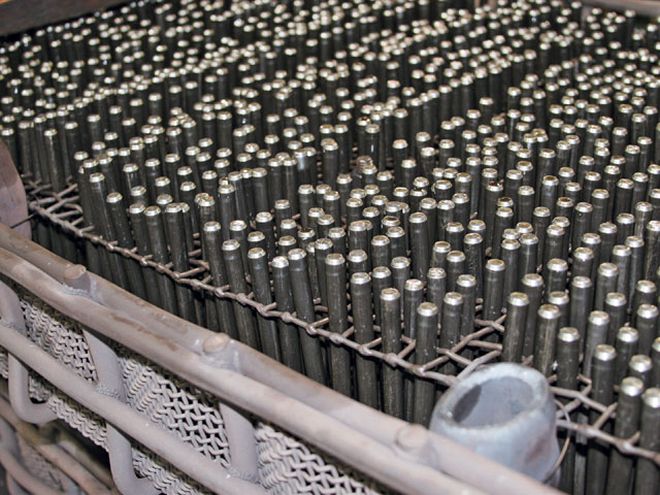 Instead of dumping the parts into a basket for heat treating, ARP stacks these studs vertically in special racks, to ensure consistent heat circulation and penetration on every single part.
Instead of dumping the parts into a basket for heat treating, ARP stacks these studs vertically in special racks, to ensure consistent heat circulation and penetration on every single part.
ARP's largest customer for high-strength bulk stainless steel is Totally Stainless, according to TS owner Doc Hammett. Whereas ARP has built its reputation on its driveline fasteners, Totally Stainless has made its name with larger suspension hardware, body kits, and engine component kits.
Doc explained to us that, relative to the huge amount of science that goes into developing high-strength rod bolts and valvetrain fasteners, everything outside of that falls into the "big hammer" category. We think he might have been pulling our leg, but fastener choice for external components is less technically critical than for the internals of an engine. Even so, choosing the right strength fastener for the right application, especially on suspension components, is important
Since there is less "science" involved in fasteners for suspension, trim, accessories, interiors, and other areas of a project car, this is where builders might feel more inclined to save a few bucks with generic nuts, studs, bolts, screws, and washers, from Pop's Hardware down the street. As someone who has developed countless correct fasteners for numerous classic car applications, Doc can anticipate the specific problems those hot rodders will encounter. He knows, for example, that interior trim screws, as early as the '30s, generally had undersized heads, and that a standard-size head will end up sticking out of place. Totally Stainless has the original-style screws in their inventory. Hood hinges, while not as punishing as a connection rod, are another problem. The factory used special, heavy flat washers that wouldn't fold up in the slotted mounting holes. Thin, flat washers are unusable for this application. Totally Stainless stocks the correct ones. Finding a source for correct fastener specs will pay off more than saving a buck on standard stuff.
Grade Nominal Size Range Min. Yield Strength Min. Tensile Strength 2 1/4" to 3/4" {{{57}}},000 psi 74,000 psi 3/4" to 1 1/2" 36,000 psi 60,000 psi 18-8 1/4" to 5/8" {{{80}}},000-{{{90}}},000 psi {{{100}}},000-125,000 psi 3/4" to 1" 45,000-70,000 psi 100,000 psi Above 1" 45,000-70,000 psi 80,000-90,000 psi 5 1/4" to 1" 92,000 psi 120,000 psi 1" to 1 1/2" 81,000 psi 105,000 psi 8 1/4" to 1 1/2" 130,000 psi 150,000 psi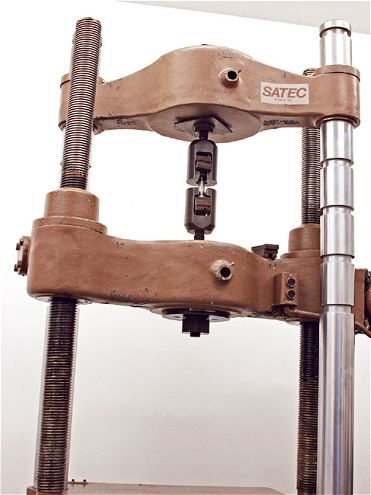 The moment we'd been waiting for-breaking stuff. This machine evaluates tensile strength by clamping the fastener at both ends and stretching it until it breaks. This one broke in the coarse thread area at the minor diameter.
The moment we'd been waiting for-breaking stuff. This machine evaluates tensile strength by clamping the fastener at both ends and stretching it until it breaks. This one broke in the coarse thread area at the minor diameter.
Lockers, Lubes & Torque
One frequently arising issue involves the effect of thread locker or antiseize lubricant on torque specs. One disadvantage of stainless is that it is more likely to gall than other materials, especially when using stainless fasteners with stainless or aluminum. Therefore, thread locker or antiseize is recommended to reduce friction and prevent this. Some care is necessary when using lockers, however, since the compounds set very quickly. Bob Florine recommends adding the compound and installing each bolt one at a time, so it doesn't have a chance to set before you want it to. When using antiseize, which is slicker than oil, Doc Hammett recommends reducing the torque setting by approximately 30 percent.
Adequate torque is required to stretch the bolt, allowing it to fasten like a clamp. The following chart, taken with permission from the Totally Stainless catalog, lists recommended tightening torques.
Single or Double Shear
Why do you need beefier suspension fasteners on your mild street rod than on your musclecar? The chassis bolts on factory cars going back for decades are double shear, meaning that the bolt runs through a double bracket, with a piece against the head and a piece against the nut. Some current aftermarket chassis use a single-shear bracket. This design puts more bending load on the bolt, making it easier to bend it or break it. The solution is to use stronger fasteners.